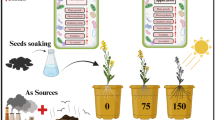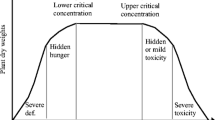Abstract
Petroleum hydrocarbons are important characteristic pollutants in the process of oil exploitation in the Yellow River Delta (China), and they cause a potential hazard to the surrounding ecological environment. The research on eco-toxicological effects of petroleum-derived products still needs to be studied in depth. This paper describes the physiological indices of wheat (Triticum aestivum L.) seeds and seedlings under independent stresses of acetone, 2-pentanone, and 2-hexanone to determine the toxicological effects of ketones derived from petroleum products on typical crops. The experimental results indicated that ketones with concentrations lower than 0.4 mg·cm−2 and 800 mg·kg−1 the germination of wheat seeds and the growth of seedlings were promoted to 113.32–127.27% and 105.41–126.39%, respectively, thus exhibiting low-dose excitatory effects. However, when the concentration was higher than 0.4 mg·cm−2 and 800 mg·kg−1, germination and seedlings’ growth were significantly reduced to 7.14–2.12% and 35.09–13.33%, respectively. At the same time, acetone had a greater impact on the growth of wheat seed roots, the malondialdehyde (MDA), and chlorophyll contents in leaf tissues. The low concentration of acetone had a significant promoting effect on the activity of α-amylase in wheat seeds. 2-Pentanone reduced the electrical conductivity of wheat seed extract, and it significantly promoted the catalase (CAT) activity at low concentrations. 2-Hexanone had a strong inhibitory effect on wheat germination and growth. This study provided new research results to determine the toxic effects of petroleum-derived products and provided a basis for the environmental management of such substances.





Similar content being viewed by others
Data availability
I would like to declare that the work described was original research that has not been published previously, and not under consideration for publication elsewhere, in whole or in part.
References
Ali D, Verma A, Pathak AK, Ali H, Hans RK (2016) UVR-induced toxicity of sludge and polycyclic aromatic hydrocarbons on seed germination and seedling growth of Triticum aestivum L. Chem Ecol 32(5):446–459
Asadu CLA, Igboka CR (2014) Effects of animal faeces and their extracts on maize yield in an ultisol of eastern nigeria. J Agric Sustain 5(1):1–13
Beasley A, Belanger SE, Brill JL, Otter RR (2015) Evaluation and comparison of the relationship between NOEC and EC10 or EC20 values in chronic Daphnia toxicity testing. Environ Toxicol Chem 34(10):2378–2384
Cao Q, Steinman AD, Yao L, Xie L (2017) Increment of root membrane permeability caused by microcystins result in more elements uptake in rice (Oryza sativa). Ecotoxicol Environ Saf 145:431–435
Che Z, Tian Y, Zhou J, Liu S, Chen G (2017) Influence of Imidacloprid and Triadimefon on wheat seed germination. Guizhou Agric Sci 5(45):20–23
Deng X, Qian Q, Sun C (2014) Toxic effects of Lindane and Chlorpyrifos on freshwater algae. Ecol Environ Sci 23(3):472–476
Fu L (2019) Identification of saline-alkaline tolerance and physiological and biochemical response mechanisms of different oat genotypes. Heilongjiang Bayi Agricultural University
Fu N, He M, Zhuge Y, Dai X, Hu G, Dong Y (2019) Effects and mechanisms of exogenous SA alleviating the growth of winter wheat seedlings under salt stress. J China Agric Univ 3(24):10–17
Grifoni M, Rosellini I, Angelini P, Petruzzelli G, Pezzarossa B (2020) The effect of residual hydrocarbons in soil following oil spillages on the growth of Zea mays plants. Environmental Pollution, 265(Pt A):114950
Guo M, Gong J, Zeng G (2016) Comprehensive phytotoxicity assessment of multi-wall carbon nanotubes on rice seedlings. Asian J Ecotoxicol 11(05):94–102
He F, Jiang X, Yao C (2018) Co-toxicity of chlorantraniliprole with six insecticides against Agrotis ipsilon. Plant Prot 44(6):236–241
Hentati O, Lachhab R, Ayadi M, Ksibi M (2013) Toxicity assessment for petroleum-contaminated soil using terrestrial invertebrates and plant bioassays. Environ Monit Assess 185(4):2989–2998
ISO. (1995). Effect of chemicals on the emergence and growth of higher plants. In ISO, (Ed.), (pp. 11262-11269). ISO.
Junior F M R D, Monarca R I, Dias D, Ramalhinho M G, Baisch A L M (2012) Physiological damage in Algerian mouse Mus spretus (Rodentia, Muridae) exposed to crude oil. Journal of bioscience & biotechnology1(2):125–133
Khaliq A, Aslam F, Matloob A, Hussain S, Geng M, Wahid A, Rehman HU (2015) Seed priming with selenium: consequences for emergence, seedling growth, and biochemical attributes of rice. Biol Trace Elem Res 166(2):236–244
Li H, Zhou Y, Xin W, Wei Y, Zhang J, Guo L (2019a) Wheat breeding in northern China: achievements and technical advances. Crop Journ 2019(7):718–729
Li J, Zhou Z, Liu Q, Chen Q (2019b) Physiological and biochemical influence of different iron oxide nanoparticles on wheat seedlings. Southwest China J Agric Ences 32(05):1004–1010
Li Y, Huang M, Shen F, Guo H (2017) Phytotoxic effects of biochar on seed germination and early growth of wheat. Asian J Ecotoxicol 012(001):234–242
Liu S, Yang C, Xie W, Xia C, Fan P (2012) The effects of cadmium on germination and seedling growth of Suaeda salsa. Procedia Environ Sci 16:293–298
Lr A, Mv B, Mak B, Dm C, Mt B (2019) The contribution of lipid peroxidation to membrane permeability in electropermeabilization: a molecular dynamics study. Bioelectrochemistry 125:46–57
Mao H, Wang Z, Graham L, Glenn M (2011) Effects of selenium valence states and concentration on germination and root growth of six crop species. J Agro-Environt Sci 30(10):1958–1965
Parlak U, Kadiriye (2016) Effect of nickel on growth and biochemical characteristics of wheat (Triticum aestivum L.) seedlings. NJAS-Wagen J Life SC 76:1–5
Pedersen JE, Strandberg-Larsen K, Andersson M, Hansen J (2020) Occupational exposure to specific organic solvents and risk of subtypes of breast cancer in a large population of Danish women, 1964–2016. Occup Environ Med:2020–106865
Pena LB, Azpilicueta CE, Gallego SM (2011) Sunflower cotyledons cope with copper stress by inducing catalase subunits less sensitive to oxidation. J Trace Elem Med Biol 25(3):125–129
Prytulak R, Naherniuk D, Karpenko VP, Pavlyshyn S (2019) Content of malondialdehyde and activity of enzyme glutathione-S-transferase in the leaves of emmer wheat under the action of herbicide and plant growth regulator. Agron Res 17(1):144–154
Qin G, Li X (2011) Hazards and bioremediation of oil-pollutants in soil yellow river delta and coastal wetland. Hubei Agricultural Sciences 50(19):45–49
Qiu Y (2017) Analysis of forming factors in wheat seed vigor. Northwest A&F University
Shao Q, Li W, Yan S, Zhang C (2019) Allelopathic effects of different weed extracts on seed germination and seedling growth of wheat. Pak J Bot 51(6):2159–2167
Singh N, Singh HP, Batish DR, Kohli RK, Yadav SS (2020) Chemical characterization, phytotoxic, and cytotoxic activities of essential oil of Mentha longifolia. Environ Sci Pollut Res 27(12):13512–13523
Talukdar D (2011) Effect of arsenic-induced toxicity on morphological traits of Trigonella foenum-graecum L. and Lathyrus sativus L. during germination and early seedling growth. Curr Res J Biol Sci 3(2):116–123
Tang J, Wang M (2011) Eco-toxicity of petroleum hydrocarbon contaminated soil. J Environ Sci (China) 23(5):845–851
Wang D, Du J, Li Y, Chu S (2016) The influence of mercury in the soil stress on physiological characteristics of forage. J Earth Environ 7(6):606–612
Wang L, Quan Y, Li X, Liu D, Chen Z (2020) Activity of α-amylase in wheat seed germination at different altitudes in Qinghai: comparison. J Agric 10(7):19–23
Wang W, Chen L, Liu Z, Wang X, Zhang C (2015) Effects of chromium(VI) and lead on the growth and reproduction of Eisenia fetida in Nanjing soils. Environ Chem 34(10):1839–1844
Wang Y, Ma X, Wang J, Cheng S, Wang Y (2019) Effects of mercapto-functionalized nanosilica on Cd stabilization and uptake by wheat seedling (Triticum aestivum L.) in an agricultural soil. Bull Environ Contam Toxicol 103(6):860–864
Wang Z, Jia J (2015) Clinical and magnetic resonance characteristics of acetone-induced toxic encephalopathy. The compilation of the papers of the 18th National Neurology Academic Conference of the Chinese Medical Association: Part 2
Zhou L, Xia M, Wang L, Mao H (2016) Toxic effect of perfluorooctanoic acid (PFOA) on germination and seedling growth of wheat (Triticum aestivum L.). Chemosphere 159 (2016):420–425
Xu C, Shi Q (2016) Structure and modeling of complex petroleum mixtures. Springer International Publishing
Xue Y, Wang Y, Zhao C, Wang Z (2016) Effects of copper stress on germination and antioxidant system in wheat seedings. Acta Agric Univ Jiangxiensis 38(01):54–59
Yu L, Wang X, Li X, Wang Y, Kang H, Chen G, Fan X, Sha L, Zhou Y, Zeng J (2019) Protective effect of different forms of nitrogen application on cadmium-induced toxicity in wheat seedlings. Environ Sci Pollut Res 26:13085–13094
Zhang M, Yang H, Lei C (2017) A preliminary study on allelopathy of Pogonatum inflexum aqueous extract. Agric Sci Technol 11(18):2168–2170
Zhang P, Zheng X, Huang X, Chen Y, Lu W (2019) Effect of hydrogen sulfide on growth and physiological indices of wheat seedlings under cadmium stress. J Triticeae Crops 039(003):329–337
Zhang Y, Wang L (2015) Effects of pb stress on seed germination and seedling growth of durum wheat. Shandong Agric Sci 3(47):68–71
Zhou G, Long W, Lei Y, Chen D, Cai Q, Wu S (2018) Effect of storage temperature on the seed viability,alpha amylase activity and its gene expression at germination stage of lincang hulled wheat. J Triticeae Crops 3(38):275–284
Funding
This work was supported by the NSFC (21477067, 21777088, and U1806216), the Cultivation Fund of the Key Scientific and Technical Innovation Project, Research Fund for the Doctoral Program of Higher Education and Ministry of Education of China (708058, 20130131110016), and the Science and Technology Development Plan of Shandong Province (2014GSF117027).
Author information
Authors and Affiliations
Contributions
Meifei Li: Conceptualization, Writing - original draft and editing, Formal analysis, Investigation, Methodology, Data curation. Kailun Sun: Investigation, Formal analysis, Visualization, Writing - review. Youshuai Fang: Investigation, Formal analysis. Meng Zheng: Resources. Xiaoyu Xie: Supervision. Jingchun Tang: Funding acquisition, Project administration. Rutao Liu: Conceptualization, Validation, Writing - review and editing.
Corresponding author
Ethics declarations
Ethical approval
Not applicable.
Human and animal rights and informed consent
This article does not contain any studies with human participants or animals performed by any of the authors.
Author approval
All authors have seen and approved the manuscript, and it has not been accepted or published elsewhere.
Consent to participate
Not applicable.
Consent for publication
The manuscript has been approved for publication by all authors.
Competing interest
All authors declare that they have no known competing financial interests or personal relationships that could have appeared to influence the work reported in this paper.
Additional information
Responsible Editor: Gangrong Shi
Publisher’s note
Springer Nature remains neutral with regard to jurisdictional claims in published maps and institutional affiliations.
Highlights
• The germination and growth of wheat (Triticum aestivum L.) have been promoted at low concentrations of ketones, and they were inhibited by high concentrations.
• Root growth was greatly affected by acetone and germination was significantly inhibited by 2-hexanone.
• Catalytic and protective enzyme activities were promoted by ketones with a concentration of less than 0.4 mg·cm−2.
Rights and permissions
About this article
Cite this article
Li, M., Sun, K., Fang, Y. et al. Toxic effects of acetone, 2-pentanone, and 2-hexanone on physiological indices of wheat (Triticum aestivum L.) germination and seedlings. Environ Sci Pollut Res 28, 64552–64560 (2021). https://doi.org/10.1007/s11356-021-15496-9
Received:
Accepted:
Published:
Issue Date:
DOI: https://doi.org/10.1007/s11356-021-15496-9




